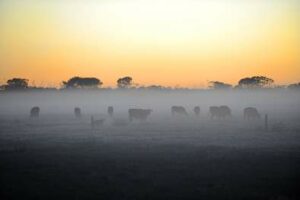Read the latest information on
Foot-and-mouth disease

Autumn is a busy time on some farms with spraying, sowing, hand feeding and lambing in full swing. The increased activity can leave some producers time poor which could mean using contractors to get all the jobs done.
Contractors, like all visitors, pose a biosecurity risk of introducing disease, pests and weeds. To help limit any potential incursions, producers should have a fit-for-purpose visitor protocol.
To do this think about the management practices you may need extra help with – do you get a contractor to sow forage crops, or do you possibly have a casual employee who feeds and checks the sheep while you are sowing?
Next think about the equipment they require – do you provide all the equipment? Are they bringing their own tractors and vehicles? If your visitors bring their own equipment, you need to ensure that this equipment is clean and free from pests and weeds. The easiest way to do this is to advise contractors prior to coming to your farm that you have an on-farm biosecurity plan, which means all machinery and equipment must be thoroughly cleaned prior to entering the farm. If contractors arrive with dirty or contaminated equipment (especially in the wheel arches and under the carriage) you could provide them with a suitable wash down area to decontaminate.
After considering the contractors equipment, you need to think about the contractors’ clothes and boots. Most contractors are acutely aware of the potential biosecurity risk they pose moving between farms, however it is always good practice to provide a wash down area. A wash down area can be as simple as a tap or hose, a boot wash tub, a brush and hoof pick and some soap. Think about whether you have an area around your shed or property entry that you could set up as a wash down area. Just like prime real estate, position is everything – choose a location that is convenient and that the contractor can easily access prior to coming into contact with any livestock.
Keep a record of who is entering your property –whether in your farm diary or a designated visitor log – recording the name, contact number, date of entry and reason for the visit is essential. If you have an intensive enterprise where multiple contractors come on farm (for example a feedlot or you have multiple employees) it is helpful to also give contractors a risk rating. Visitors who enter areas where livestock are grazed (the paddocks) or worked (lane ways, yards and holding paddocks) are the highest risk. It is important to recognise the potential risk each contractor may pose to ensure the highest biosecurity protocols are maintained for high-risk visitors. Contractors (like mechanics) that only work around the sheds are less risk than lamb marking contractors who are handling your livestock.
The final step in developing a fit-for-purpose visitor protocol is hanging a biosecurity sign at the front gate that clearly states that your property has a biosecurity plan, who to report to and where to go when visitors arrive.